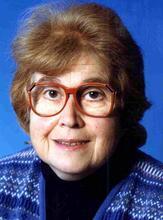Dora Gad
Grave of Israeli Interior Designer Dora Gad (and Efraim Ben Arzi), December 2, 2017
From Wikimedia Commons
Dora Gad was a prominent Israeli architect and interior designer. She graduated from the Technical University of Vienna in 1934 and immigrated to Palestine in 1936. Gad had an extremely successful, impressive, and long career, and her work stood out for its innovation and its important contribution to interior design in Israel. In the early decades of Israel's statehood, Gad played a key role in designing projects for the newly established national institutions. Among them were the Knesset (Israel's parliament building), the Israel Museum, the national library, nine ships of the Israeli maritime company ZIM, the offices of Israel's newly founded national airline El Al, and the interior of El Al's three new airplanes. In 1966, she received the Israel Prize in architecture for designing the Israel Museum, the first woman to have ever received this prize.
Dora Gad was a prominent Israeli architect and interior designer and the first woman to win the Israel Prize in architecture. Gad had an extremely successful, impressive, and long career that began in Palestine under the Mandate for Palestine given to Great Britain by the League of Nations in April 1920 to administer Palestine and establish a national home for the Jewish people. It was terminated with the establishment of the State of Israel on May 14, 1948.British Mandate, 1920-1948) and developed further after the establishment of the state of Israel. Her work stood out for its innovation and for its important contribution to interior design in Israel. In the early decades of Israel's statehood, Dora Gad played a key role in designing projects for the newly established national institutions.
Family and Education
Dora Siegel was born in 1912 in the Romanian town of Campulung. Her father, Baruch, was a civil servant. While her education included both a Jewish and a government school, the culture she absorbed at home was a central European one. From 1930 to 1934 she studied architecture at the Technische Hochschule Vienna (TH; today the Technical University, or TU), where she met her husband-to-be, Yehezkel (Heinrich) Goldberg (later Gad) (1911–1958), who was also a student there. In January 1935, after her graduation, she passed the government certification exam for architects and moved to Bucharest.
Yehezkel Goldberg, an ardent Zionist, managed to acquire a certificate allowing him to immigrate legally to The Land of IsraelErez Israel. Dora and Yehezkel married in 1936, and Dora joined her husband. The two settled in Tel Aviv. Like many other German-speaking architects, they both found work in the offices of fellow German-speaking architects who had arrived in Palestine earlier. Yehezkel Goldberg was hired by the office of Alfred Abraham and Helene Roth. Dora found a job at the office of Oskar Kaufmann.
Developing a Unique Design Style
In 1938, Gad launched an independent career. Her early designs of Tel Aviv shops classified her as an “interior designer.” In 1942, her husband joined her in her work. They became professional partners and proceeded to co-design the interiors of private apartments and shops. Dora and Yehezkel Gad worked together for sixteen years, until Yehezkel fell ill in 1958 and died at the age of 47. Dora then entered into professional partnership with Arie Noy, a longtime employee in her office. The Gad-Noy office remained in business until 1976.
Dora Gad's unique local style emerged over the decade that preceded the establishment of the State of Israel in 1948, and it became increasingly distinctive and individual in the 1950s. The spaces and objects she designed were rich in color. In her works, she used a variety of materials, such as woolen rugs, wickerwork, straw mats, and cotton fabrics, that represented local crafts and Israeli art. Her furniture and hanging art pieces were light and airy. They all reflected her interpretation of the region's design language combined with her modern European education.

Interior of the flagship “Shalom” of Zim, Israel’s first national commercial maritime company, designed by Israeli architect and designer Dora Gad, 1964. Photograph by Photo Sade. The Dora Gad Archive, courtesy of College of Management Academic Studies & The Israel Architecture Archive (IAA), can now be accessed online as part of a collaborative initiative between The Ministry of Jerusalem and Heritage, The National Library of Israel, Bezalel Academy of Arts and Design and the Judaica collection at the Harvard University Library.
After the establishment of the State of Israel and through the 1950s, Dora and Yehezkel Gad were the most prominent interior designers in Israel. Together, they received commissions for major national projects in various fields. Through their work on these projects, they developed a new design concept that corresponded to the self-image of the young state. Their projects included official buildings and public institution: the residence of the foreign minister (Jerusalem, 1950), which later became the official residence of Israel's Prime Ministers; the national library (Jerusalem, 1956); Israel's embassies in Washington and Ankara; the offices of El-Al, Israel's newly founded national carrier, in New York (1956) and London (1959); and the interior design of El-Al's three new airplanes, named Britannia after their country of origin.
During the 1950s, Gad increased her use of symbolic and representative motifs and eventually crystallized an idealized formal style that became identified with her. This symbolic language combined different components, especially wall art and murals that featured biblical, archeological, and Zionist motifs. These components highlighted ethnic and folkloristic nuances that represented the ideal of the young state and were her way of expressing the consolidation of Israel's many immigrant communities into one culturally integrated nation. At the same time, her artistic language adhered to modern esthetics, representing the modesty, simplicity, and innovative spirit of the young State. Dora Gad attached great importance to incorporating Israeli art in the public interiors she designed, promoting individual male and female artists and Israeli art as a whole.
From the mid-1950s on, Gad's office specialized in designing ship interiors for Zim, Israel's first national commercial maritime company, in collaboration with the Alfred Mansfeld and Munio Weinraub architectural firm. Gad designed the interiors of nine ships, three cargo ships and six passenger ships, including ZIM's flagship “Shalom” (1964). She also cooperated with Ruth Dayan and fashion designer Fini Leitersdorf at the Maskit fashion house, whose products combined modernity with ethnic motives and materials, and used many of their products in her design projects. In 1959, Dora married Efraim Ben Arzi (1910–2001), a veteran general and a prominent public figure. Dora designed their house in Caesarea (1974).
Recognition
Throughout the 1960s, Dora Gad continued to be involved in planning key national projects in Israel. The restrained and dignified style she developed for those projects defined the visual language that became identified with formal Israel of that time. Two of Gad's most important and prestigious works were the Israel Museum, a commission she won together with architect Al Mansfeld following a competition, and the interior design of the Knesset, Israel's parliament building. In 1966, Gad and Mansfeld received the Israel Prize in architecture for designing the Israel Museum. In awarding her this most important and prestigious Israeli prize, the judges also paid tribute to her 30 years of work, during which she advanced and shaped Israel's interior design world. In 1966, Gad also won the coveted design prize Regulo d'Oro, awarded annually by the Italian design monthly Domus, for her planning of modular units made of prefabricated concrete.
Along with her work for the public sector, Gad continued to design luxury hotel interiors for the private sector. In 1955 she designed Hasharon and Accadia hotels in Herzliya, and in 1965 she designed the Tel Aviv Hilton hotel and later the Jerusalem Hilton hotel (1974), which were the largest in the country. In these works, she used an international visual language of luxury and opulence, while maintaining the special characteristics of Israeli design. When her husband left his position as general manager of El Al, Dora resumed her work for the airline and designed its offices in Zurich, Amsterdam, Brussels, and Bucharest (1974–1980). She also designed the Ben-Gurion airport terminal interior (1973) and the El Al terminal at Kennedy airport in New York (1970 and 1974).
When her partnership with Arie Noy ended in 1976, Gad continued to work on her own and became involved in a wide variety of projects. Among them were the offices of the governor of the Bank of Israel (Jerusalem, 1980), the refurbishment of the official residences of the prime minister and the president (1984), the Diamond Museum (Ramat Gan, 1986), hotels, restaurants, and offices. Her last work was the interior design of Beit Gavriel on the Kinneret (1993).
In 1994, at the age of 82, after five decades of a successful and groundbreaking career, the prestigious Tel Aviv Museum of Art invited Gad to hold a retrospective exhibition, which she naturally designed herself. Once again, she proved to be a pioneer: To this day, no other woman architect has held a retrospective exhibition in Israel. The exhibition encapsulated over 50 years of productive work, during which she was acknowledged as the official, almost national representative of Israeli interior design. Dora Gad died on December 31, 2003, at the age of 91.
Gad's scanned archive, Israel National Library, Jerusalem.
Vienna University of Technology Archive.
Davidi, Sigal. Building a New Land: Women Architects and Women's Organizations in Mandatory Palestine. Ra'anana: Open University Publishing House, 2020.
Shechori, Ran. Dora Gad: The Israeli Presence in Interior Design. Architecture in Israel (Hebrew and English). Tel Aviv: Tel Aviv Museum of Art, 1997.
Zandberg, Esther. “Dora Gad, 1912–2003.” Haaretz, January 2, 2003.



















